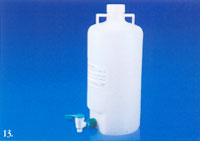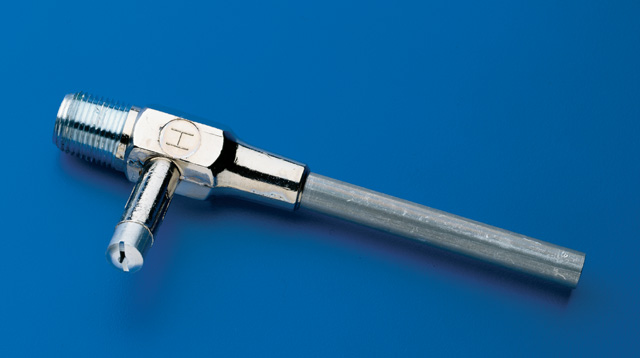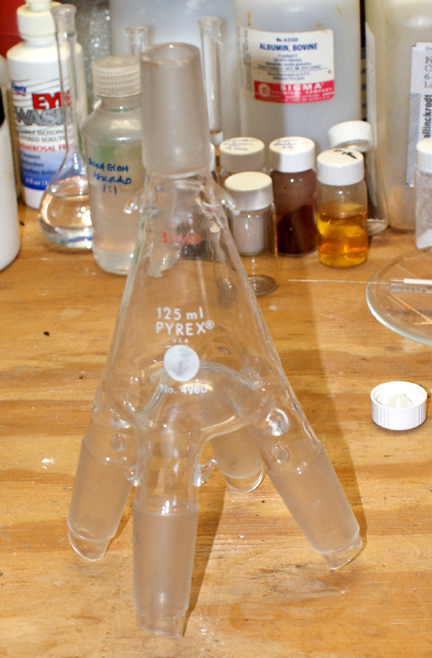| Pages:
1
2
3
4 |
taniya.pinkpower1986
Harmless

Posts: 13
Registered: 3-11-2008
Location: pink island
Member Is Offline
Mood: you know
|
|
Practical Vacuum Distillation
I have practical experiance in working with Liebig,Vigreux and many other Condensers.But when it comes to Vacuum Distillation its a diffrent story I
only have some theoritical knowledge about Vacuum Distillation but no practical experiance.IF ANY MEMBER HERE HAVE SOME PRACTICAL KNOWLEDGE ON VACUUM
DISTILLATION PLEASE SHARE IT.It would be of great help if some one tells,how to set up apparatures to perform Vacuum Distillation?
|
|
|
taniya.pinkpower1986
Harmless

Posts: 13
Registered: 3-11-2008
Location: pink island
Member Is Offline
Mood: you know
|
|
Practical Vacuum Distillation

|
|
|
taniya.pinkpower1986
Harmless

Posts: 13
Registered: 3-11-2008
Location: pink island
Member Is Offline
Mood: you know
|
|
Above pic is that of an Aspirator that I am going to use
|
|
|
tentacles
Hazard to Others
  
Posts: 191
Registered: 11-11-2007
Member Is Offline
Mood: No Mood
|
|
That would appear to be a carboy, not an aspirator. I use a vacuum distillation rig to distill acids (HNO3, acetic). It's just a cheap plastic
aspirator, some PE tubing from the hardware store, and a repurposed ammonia distilling rig. I am too cheap to own a heating mantle so I float the RBF
in a pot of water on a hotplate/stirrer. I assemble the joints with teflon tape and the merest smear of silicone grease to get a solid seal.. I don't
even use clamps, the vacuum does a fair job of holding things together when the apparatus are setup right. I DO cover the top of the RBF and wrap the
glass tubing to the top of the condenser to keep efficiency up. There's no need to reflux if you're just distilling nitric from H2SO4 and a nitrate
salt.
edit: I should note, the plastic aspirator that I purchased had no nozzle, so in stock configuration it sucked badly. I machined a bit of UHMW on my
lathe with a 1.6mm hole and crammed that in the top of the aspirator. I tried also with a 2mm hole and got harder vacuum, and more flow but the water
consumption was about 2x that of the slightly smaller aperture. I still get about 24-26" of vacuum with mere city water pressure.
another edit: What are you planning on vacuum distilling, anyways? That would be helpful to indicate what kind of stuff you need to do the job safely
and properly.
[Edited on 30-1-2009 by tentacles]
|
|
|
taniya.pinkpower1986
Harmless

Posts: 13
Registered: 3-11-2008
Location: pink island
Member Is Offline
Mood: you know
|
|
Practical Vacuum Distillation
Well for me cost is the biggest issue I will probably use a plastic aspirator like u have used.Any ways IT WOULD BE NICE IF PICTURE OF A VACUUM
DISTILLATION SET UP IS POSTED.Seeing into it probably I can set up my own
Attachment: Aspirators with stopcock Catalouge.pdf (321kB)
This file has been downloaded 1445 times
|
|
|
taniya.pinkpower1986
Harmless

Posts: 13
Registered: 3-11-2008
Location: pink island
Member Is Offline
Mood: you know
|
|
Ohhhhhh sorry! By the way above I have posted catalouge of a company which makes Aspirators for lab use(in PDF)
|
|
|
Saerynide
National Hazard
   
Posts: 954
Registered: 17-11-2003
Location: The Void
Member Is Offline
Mood: Ionic
|
|
Theres not much to it that differs from normal distillation. Just hook the setup to the trap and aspirator and distill away as you would normally.
Make sure you release the vacuum before you shut off the water, or water will be sucked in.
"Microsoft reserves the right at all times to monitor communications on the Service and disclose any information Microsoft deems necessary to...
satisfy any applicable law, regulation or legal process"
|
|
|
Saerynide
National Hazard
   
Posts: 954
Registered: 17-11-2003
Location: The Void
Member Is Offline
Mood: Ionic
|
|
http://orgchem.colorado.edu/hndbksupport/dist/distsetup/vacd... << pictures of set up like you mentioned
"Microsoft reserves the right at all times to monitor communications on the Service and disclose any information Microsoft deems necessary to...
satisfy any applicable law, regulation or legal process"
|
|
|
Sauron
International Hazard
    
Posts: 5351
Registered: 22-12-2006
Location: Barad-Dur, Mordor
Member Is Offline
Mood: metastable
|
|
There's simple vacuum distillation such as stripping solvent using a rotavap and aspirator pump, and there's fractional vacuum distillation which
involves a somewhat more complex glassware setup than does fractionation at ordinary pressure.
I reccomend
Elements of Fractional Distillation
Vogel's Practical Organic Chemistry
Synthetic Organic Chemist's Laboratory Survival Manual
The Chemist's Companion
Browsing the catalogs of Ace, Kimble/Kontes, Corning/Pyrex, LabGlass, ChemGlass, and Aldrrich will teach you a lot.
You need to:
match pot size and heat source to column and condenser capacities
Select column type (and packing if independent)
BTW a Vigreaux is a column not a condenser
Select still head (to control variable reflux ratio)
Select Takeoff system, fraction cutter, and vacuum isolation system
Select vacuum control system
Select vacuum gauge
Select vacuum pump
Select manifold if any, cold traps, check valves, suckback protection etc etc.
You also need to be concerned about possible foaming and bumping in the pot.
How are you going to cool your condensers (because you will probably have at least two condensers, one in still head and one main condenser for
downward delivery). A recirculating thermostated chiller is a great convenience especially if your main supply is not very cool.
Sic gorgeamus a los subjectatus nunc.
|
|
|
chemrox
International Hazard
    
Posts: 2961
Registered: 18-1-2007
Location: UTM
Member Is Offline
Mood: LaGrangian
|
|
I don't think she's up to vacuum pumps, traps, reflux ratio's, etc. yet.. just be sure to open the vacuum relief BEFORE shutting the aspirator off!
It is a very common mistake to turn the aspirator off and ruin the experiment with water backflow. I've done it.
"When you let the dumbasses vote you end up with populism followed by autocracy and getting back is a bitch." Plato (sort of)
|
|
|
Ozone
International Hazard
    
Posts: 1269
Registered: 28-7-2005
Location: Good Olde USA
Member Is Offline
Mood: Integrated
|
|
A drawing, mostly for a reason to play with the clips in ChemBioDraw.
I prefer to put a "T" in the vacuum line after the trap (not shown) for manual regulation...If it starts to get too frisky I let some air in with my
thumb. This works very well and really allows you to drive it (a pump works best, but an aspirator is OK).
A capillary (a Pasteur pipette with the end drawn in a flame) with a bit of tubing and a clamp can also be used to control the vacuum in the rig.
Cheers,
O3

-Anyone who never made a mistake never tried anything new.
--Albert Einstein
|
|
|
chemrox
International Hazard
    
Posts: 2961
Registered: 18-1-2007
Location: UTM
Member Is Offline
Mood: LaGrangian
|
|
Hey Oz, thanks- we'd better talk about the bleeder. In order to prevent bumping you might need to have a capillary tube entering the liquid to
release a slow stream of bubbles.
"When you let the dumbasses vote you end up with populism followed by autocracy and getting back is a bitch." Plato (sort of)
|
|
|
Sauron
International Hazard
    
Posts: 5351
Registered: 22-12-2006
Location: Barad-Dur, Mordor
Member Is Offline
Mood: metastable
|
|
That's the simplest possible setup for a vacuum distillation with no provision for fractionation.
Suitable for distilling a liquid from a solid, or seperating two liquids with a difference of >100 C in bp with reasonable efficiency.
But as soon as you want to separate two volatile liquids with a bp difference of ,100 C, things get a lot more complicated both in theory and in terms
of setup and control.
Sic gorgeamus a los subjectatus nunc.
|
|
|
taniya.pinkpower1986
Harmless

Posts: 13
Registered: 3-11-2008
Location: pink island
Member Is Offline
Mood: you know
|
|
Thanks every one,for your suggestions.I REALLY LIKE THIS FORUM FOR ALL THESE NICE MEMBERS. . Anyways can you guys give me some more ideas about the Aspirators? like how they work,how to opreate them etc?Well I am thinking of
making my Vacuum Distillation set up as Cheap and Simple as I can.Do any of you have a picture or catalouge of such aspirators?Then please post it. . Anyways can you guys give me some more ideas about the Aspirators? like how they work,how to opreate them etc?Well I am thinking of
making my Vacuum Distillation set up as Cheap and Simple as I can.Do any of you have a picture or catalouge of such aspirators?Then please post it.
|
|
|
taniya.pinkpower1986
Harmless

Posts: 13
Registered: 3-11-2008
Location: pink island
Member Is Offline
Mood: you know
|
|
Practical Vacuum Distillation

|
|
|
taniya.pinkpower1986
Harmless

Posts: 13
Registered: 3-11-2008
Location: pink island
Member Is Offline
Mood: you know
|
|
Above I have posted a pic of what appears to be an Aspirator.Can anyone confirm it?What type of Aspirator is it?How to operate this?
|
|
|
not_important
International Hazard
    
Posts: 3873
Registered: 21-7-2006
Member Is Offline
Mood: No Mood
|
|
This type is for pulling a slow stream of gas, usually air, through a system. The bottle is filled with water, the exhaust point of whatever system
is to have the gas pulled through it attached to a stopper in the top of tthe bottle, and the tap opened enough to draw the gas/air through the system
at the desired rate.
Obviously when the bottle nears being empty the action will slow and cease. It also generates only a slight vacuum, equal to the height of the water
in the bottle ( mm or cm of water). It has almost no use for distillation, one rare one being drawing CO2 through an otherwise closed distillation
system being used to distill sulfur; the slow flow of CO2 helps sweep out any gases trapped in the sulfur.
------
Per Sauron's comment below, nowadays 'aspirator' means the class of device he showed, an eductor-jet pump. In older texts these were often refered to
as filter pumps or just pumps, as in "...filtered off at the pump".
The aspirator bottle is now mostly used to supply a liquid, the tap near the bottom being useful for that, or collect the fluid from aspiration - most
in a medical context.
| Quote: |
aspirator (n):
an apparatus for producing suction or moving or collecting materials by suction ; |
[Edited on 1-2-2009 by not_important]
|
|
|
Sauron
International Hazard
    
Posts: 5351
Registered: 22-12-2006
Location: Barad-Dur, Mordor
Member Is Offline
Mood: metastable
|
|
Nope.
An aspirator (vacuum) pump is a metal or more usually plastic, inverted L-shaped device that attaches to a water faucet over a drain or sink, the side
arm has a tublation for vacuum tubing . With cold water running it can develop about 20-30 torr and that is adequate for a lot of routine work. See
Nalgene website for pics of a typical plastic aspirator. The colder your tap water the better the cacuum.
Photo below is a nice Chapman aspirator pump from Aldrich site.
[Edited on 1-2-2009 by Sauron]

Sic gorgeamus a los subjectatus nunc.
|
|
|
Ozone
International Hazard
    
Posts: 1269
Registered: 28-7-2005
Location: Good Olde USA
Member Is Offline
Mood: Integrated
|
|
Yep, that will do it. I was putting fourth the simplest case (fractionation is another topic). A vigreux (or packed column) between the pot and head
will be the simplest fractionating rig.
To make the operation go more smoothly, under vacuum, a "cow" at the end of the condenser and several receivers works best for me. By rotating the
"cow" (because of the resemblence to a cow's udder) you can collect multiple fractions without breaking the vacuum.
Cheers,
O3

-Anyone who never made a mistake never tried anything new.
--Albert Einstein
|
|
|
superman1451
Harmless

Posts: 6
Registered: 7-11-2007
Member Is Offline
Mood: No Mood
|
|
| Quote: | Originally posted by Sauron
Nope.
An aspirator (vacuum) pump is a metal or more usually plastic, inverted L-shaped device that attaches to a water faucet over a drain or sink, the side
arm has a tublation for vacuum tubing . With cold water running it can develop about 20-30 torr and that is adequate for a lot of routine work. See
Nalgene website for pics of a typical plastic aspirator. The colder your tap water the better the cacuum.
Photo below is a nice Chapman aspirator pump from Aldrich site.
[Edited on 1-2-2009 by Sauron] |
I have one of these and for some reason it would not work. I had a water hose attached to it and turned it on full but no vaccum was pulled. Does it
matter which way the aspirator is pointed? and any suggestions for getting it to work would be very appreciated
|
|
|
Ozone
International Hazard
    
Posts: 1269
Registered: 28-7-2005
Location: Good Olde USA
Member Is Offline
Mood: Integrated
|
|
The threaded end goes to the faucet, the side arm to your apparatus and the bottom to the drain. Frequently these become clogged with scale from the
water. This occurs most commonly at the interface with the side arm. If you have water flowing though the thing (and it should be jetting out) and
there is no vacuum, then the side arm must be plugged up. Usually. a quick rinse with 1:1 HCl will do the trick.
See also Venturi jet or effect. That's how it works.
Cheers,
O3
-Anyone who never made a mistake never tried anything new.
--Albert Einstein
|
|
|
watson.fawkes
International Hazard
    
Posts: 2793
Registered: 16-8-2008
Member Is Offline
Mood: No Mood
|
|
| Quote: | Originally posted by Ozone
To make the operation go more smoothly, under vacuum, a "cow" at the end of the condenser and several receivers works best for me. By rotating the
"cow" (because of the resemblence to a cow's udder) you can collect multiple fractions without breaking the vacuum. |
I'm missing something, I'm sure. Where are the valves? I don't see how you replace the flasks during the run. Or alternately, do you
simply plan the collection strategy completely in advance? In that case, I assume that you use different size flasks. How easy is it to turn the
ground glass joint under vacuum?
|
|
|
Saerynide
National Hazard
   
Posts: 954
Registered: 17-11-2003
Location: The Void
Member Is Offline
Mood: Ionic
|
|
| Quote: | Originally posted by superman1451
I have one of these and for some reason it would not work. I had a water hose attached to it and turned it on full but no vaccum was pulled. Does it
matter which way the aspirator is pointed? and any suggestions for getting it to work would be very appreciated |
It seems to work better if you put a plastic tube over it that goes into the drain (so put the end of the aspirator into a long tube). Having just
the end of the aspirator spraying water into the air doesnt do a very good job, I dunno why. Even my chem professors agree, but they werent able to
explain why lol.
"Microsoft reserves the right at all times to monitor communications on the Service and disclose any information Microsoft deems necessary to...
satisfy any applicable law, regulation or legal process"
|
|
|
superman1451
Harmless

Posts: 6
Registered: 7-11-2007
Member Is Offline
Mood: No Mood
|
|
| Quote: | Originally posted by Saerynide
It seems to work better if you put a plastic tube over it that goes into the drain (so put the end of the aspirator into a long tube). Having just
the end of the aspirator spraying water into the air doesnt do a very good job, I dunno why. Even my chem professors agree, but they werent able to
explain why lol. |
Perhaps it creates greater pressure? A member at APC suggested machining a nozzle that narrowed the outlet hole, but I don't have access to any way of
machining anything.
|
|
|
pantone159
National Hazard
   
Posts: 590
Registered: 27-6-2006
Location: Austin, TX, USA
Member Is Offline
Mood: desperate for shade
|
|
| Quote: | Originally posted by watson.fawkes
I'm missing something, I'm sure. How easy is it to turn the ground glass joint under vacuum? |
I don't understood this either - do you just rotate the ground glass joint to select the different udders? It isn't a problem to do this under
vacuum? BTW - I like that there is a bovine-derived chem in your pic of the "cow".
|
|
|
| Pages:
1
2
3
4 |